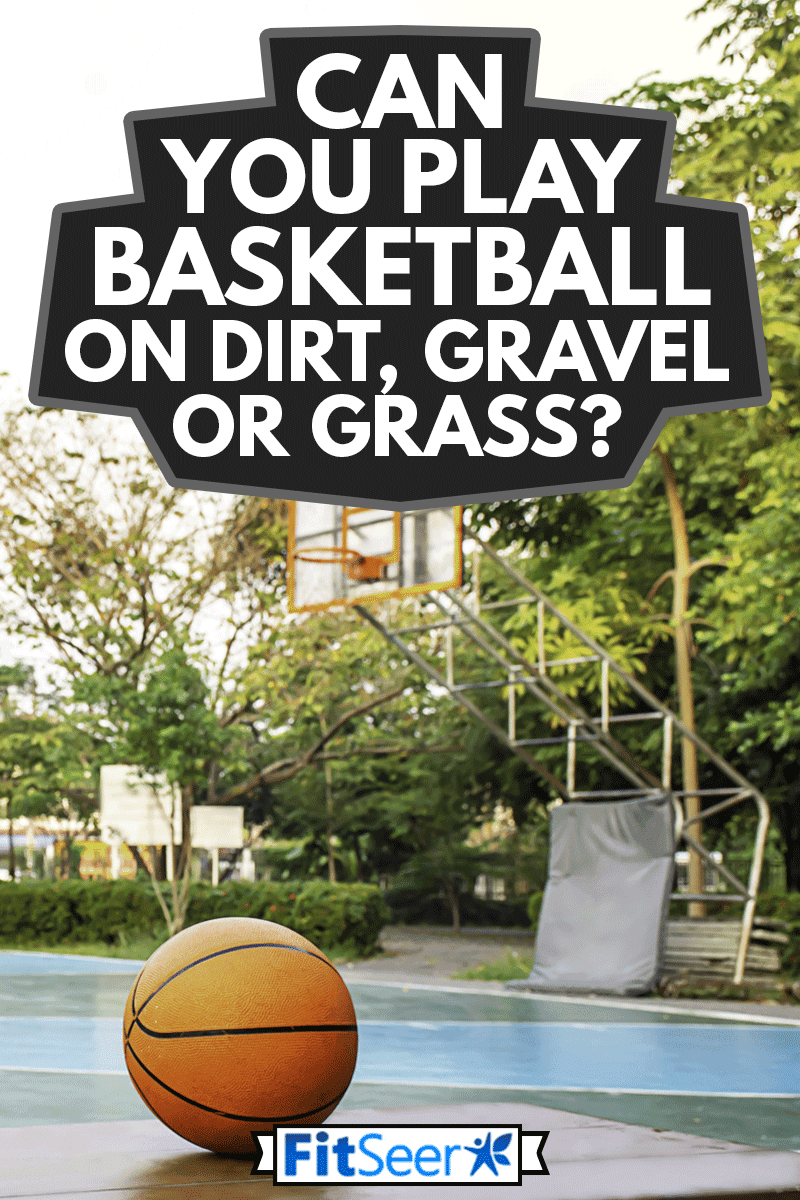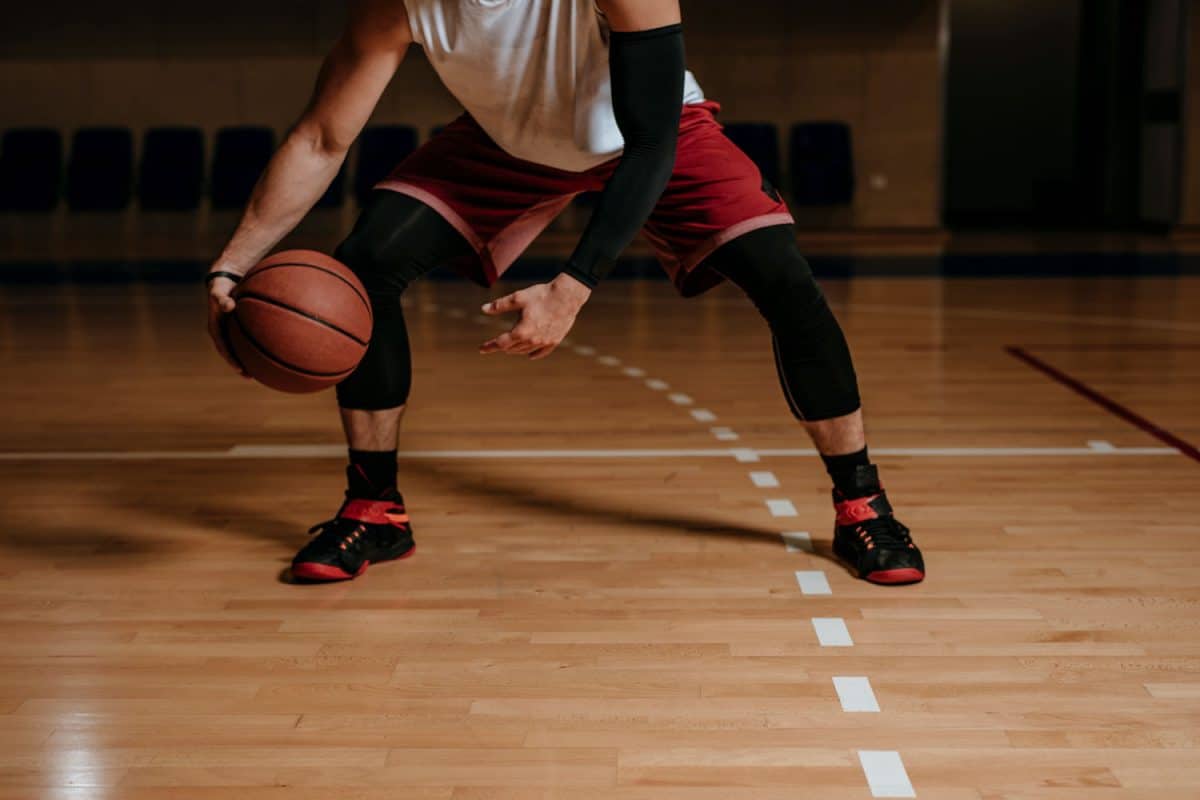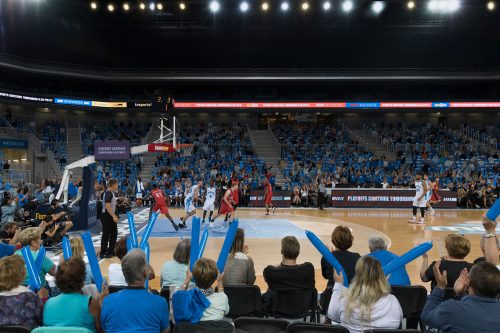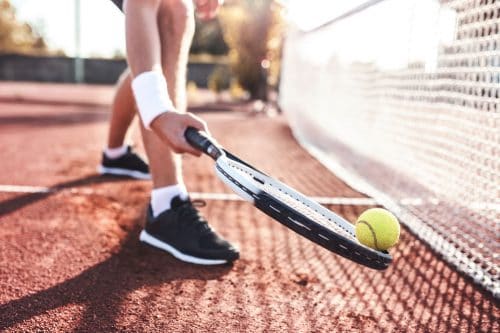Whether you play basketball for fun or are on a team, you likely know the value of hard work and practice. If you are lucky enough to have access to a paved driveway where you can put a basketball hoop, you don't have to worry about finding a place to practice. If you don't have a paved driveway, however, you might be wondering if you can play basketball on other surfaces, such as dirt, gravel, or grass. We have done the research to bring this answer to you.
It is not recommended to play basketball on grass or gravel. You may be able to play basketball on dirt under certain conditions. If you can't make it to your local gym or park's basketball court, play on these surfaces instead:
- Hardwood
- Concrete
- Asphalt
- Sport Tiles
- Pavers
We will discuss the pros and cons of playing basketball on grass, gravel, and dirt. We will also explain why we've suggested these alternative surfaces and tell you where you may be able to find them.

Dirt, Gravel, And Grass: To Play Or Not To Play?
You'll be surprised to know that while you can't play a game of basketball on any of these surfaces, except dirt in some cases, practicing on them can be beneficial for increasing your skill. Let's take a look at the pros and cons of each surface.
Dirt
The Pros
Packed, leveled dirt can be just as firm as some of the more ideal surfaces. If you can find a large enough space with packed dirt, you may be able to play a game. Even if it isn't ideal for playing a full game, practicing on dirt can also have benefits. Unless you're playing on soft sand, dirt can be hard enough for your ball to bounce.
Because it isn't perfectly smooth, though, your ball may be difficult to control at times. Adapting to this may be beneficial to you during games when you have to play against unpredictable players.
The Cons
Not all dirt can be used for playing basketball. Areas with soft dirt or sand will be impossible to play on. The ball will not bounce in these conditions, and it may even be challenging to set up a hoop for shooting baskets.
Can You Dribble A Basketball On Dirt?
Yes. Dribbling a basketball on dirt is a great activity to do while practicing. Dirt isn't ideal for dribbling because the dirt isn't dense or hard enough for the basketball to move like it is supposed to. Learning how to handle the ball in these conditions will give you better control of the ball during games.
Gravel
The Pros
You can practice shooting baskets on gravel as long as your basketball hoop is sturdy enough. Gravel pavers can make a suitable playing surface since they are smooth and firm like concrete.
The Cons
Loose gravel is nearly impossible to play basketball on. The ball will sink into the stone rather than bounce, and you must be careful that you do not get hurt on the small, sometimes sharp rocks.
Grass
The Pros
Having grass in your yard may make it difficult to dribble the ball, so you likely won't be able to play a full game, but you can practice shooting hoops. Turn your playing time in the grass into a shooting clinic and practice making baskets at different distances from the net. Your shooting skills will improve even if you can't dribble the ball. Because the ball can't bounce that well, you won't have to waste a lot of time chasing the ball after you take a shot.
The Cons
As we've already mentioned, you can't dribble a ball on the grass. The grass is too soft to provide enough energy for the ball to bounce back. This may be okay for drills, but you will not be able to play a game with your friends. Another drawback of playing on the grass is that it can be uneven, which can cause injury.
Does A Basketball Bounce On Grass?
As long as the basketball is inflated correctly, it will bounce on the grass. However, it likely will not bounce high enough to reach your hands.
What Can I Put Over Grass To Play Basketball?
You can install court tiles in your yard to create a basketball court. Choose from smooth tiles that resemble a gym floor or slip-resistant rubber mat flooring. The tiles lock together so you can make as big of a court as you need.
Click here to see these tiles on Amazon.
Recommended Surfaces For Basketball
In a pinch, dirt, gravel, and grass allow you to at least practice making baskets. However, there are more suitable alternatives you should play on if you can access them.
Hardwood
![A basketball court floor with a ball and athletic shoes, Should Basketball Shoes Be Tight? [Important Fitting Tips!]](https://fitseer.com/wp-content/uploads/2020/10/A-basketball-court-floor-with-a-ball-and-athletic-shoes.jpg)
Indoor basketball courts are made of hardwood, which is ideal for playing basketball. The smooth, firm surface makes it easy to practice dribbling, bouncing, and shooting the ball.
It also allows you to practice on the same surface you would play on if you are part of a team. Playing on hardwood also gives you the added benefit of seeing the ball more clearly, since the color of the hardwood is usually a light shade while the ball is bright orange.
Where To Find
You can find hardwood courts in school gyms and recreation centers.
Concrete
![Concrete basketball court in the backyard of a home, How To Build A Concrete Basketball Court? [5 Steps]](https://fitseer.com/wp-content/uploads/2020/10/Concrete-basketball-court-in-the-backyard-of-a-home.jpg)
Concrete is long-lasting and durable, so you don't have to worry about a court getting cracked or damaged after just a few uses. Concrete can also withstand harsh weather conditions, so you don't have to worry about weather-related damage on your favorite outdoor court.
Where To Find
If you set up a basketball hoop in your driveway or the cul de sac at the end of your street, you will likely play on concrete. Some parks and playgrounds may also have concrete courts, though most are made from asphalt.
Asphalt
Asphalt is similar to concrete in that it is durable and suitable for playing basketball. However, it is more porous than concrete, so it can better drain any water on the court.
Where To Find
Asphalt is the most popular outdoor basketball court material. Whether you go to your local playground, find an outdoor court outside of a school, or visit your local recreation center and use their outdoor courts, you are likely playing on an asphalt court.
Sport Tiles
Sport tiles are individual square tiles that can connect to create a basketball court in your preferred size. These tiles are firm enough to play basketball, but they have some give to them that puts less pressure on your joints. You can find sport tiles in a variety of styles and materials to best suit your needs.
Where To Find
Basketball courts made of sports tiles are most likely to be found in the backyards of your neighbors. You have to connect each tile together to create your basketball court, which is not always feasible for a commercial or community agency. Agencies will likely choose another surface option and contract to have it built rather than building a court themselves with tiles.
Pavers
Driveway pavers have a texture and surface similar to a cinder block. When you put many of them together, you will have a smooth surface for playing basketball. If you consider playing basketball on a driveway made of pavers, check that the pavers are close enough together. If they are spaced out or have large cracks between them, the surface will be unstable and can cause injuries.
Where To Find
Basketball courts made with driveway pavers are likely to be found in residential areas. Again, companies that open their basketball courts to the public are likely to use surfaces such as concrete or asphalt. Still, homeowners who enjoy playing basketball may choose to make a driveway out of pavers so they can install a hoop there too.
What Is The Best Surface To Bounce A Basketball On?

Hardwood and concrete are the best surfaces for bouncing a basketball. These surfaces are hard enough to give the basketball enough energy to bounce back to the player. These surfaces are also smooth, reducing the likelihood of the ball hitting a bump in the surface and rolling away.
Is Concrete Or Asphalt Better For A Basketball Court?
Sports court retailers Apex Court Builders state that asphalt and concrete are comparable for a basketball court. They are both weather-resistant, smooth surfaces that can withstand the stress and impact of basketball and remain in good condition. The surface that best suits your needs depends on the environment in which you are installing a basketball court.
Asphalt allows for better drainages, making it a better choice for wetter climates. Concrete is more durable, make it a better choice for drier climates and situations where you might be anticipating more wear and tear.
How Many Inches Of Concrete Do I Need For A Basketball Court?
Half courts are most popular for backyard installation. If you choose to install a half-court, you need 4-inch thick concrete that measures 42 feet by 50 feet. This adds up to 25.93 cubic yards, or 1167 90-pound bags, of concrete. If you are thinking about building a concrete basketball court in your yard, take a look at these articles:
How To Build A Concrete Basketball Court? [5 Steps]
How Much Does It Cost To Put A Basketball Court In A Backyard?
Summary

Try to avoid playing basketball in grass, gravel, and dirt. While they are okay to practice sometimes, they are not suitable for gameplay. Their surfaces are not firm enough for a ball to bounce correctly, and they can be a safety hazard. Choose a basketball court at your local park or recreation center instead.





![Read more about the article Should I Polish My Bowling Ball? [And How To]](https://fitseer.com/wp-content/uploads/2022/04/rack-of-old-worn-bowling-balls.-500x333.jpg)

